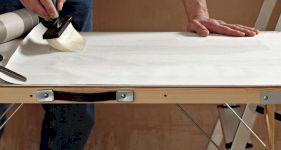Coving Installation Cost
- The average cost of coving installation is around £340.
- The job will take approximately 1 to 3 days to complete.
- Typical costs for coving installations by type and size of room.
- How long this job takes and what drives prices you're quoted up.
- How to find a local coving installer using MyJobQuote.
How much does it cost to install coving?
Coving is a stylish way to add character and a polished finish to any room.
Whether you go for lightweight modern coving or traditional decorative plaster, there’s pretty much an option to suit every home.
In this guide, we'll explore the cost of different types of coving, the process, as well as the price for professional installation.
If you want to add ceiling coving to your space, the best way to get started is by requesting a personalised quote tailored to your home and design preferences.
Are you ready for a quote?
If so, we have a wide range of local coving specialists ready to offer you a free quote!
On average, the cost to install coving typically lies anywhere between £250 and £450.

£340
Table of Contents
- How Much Does Coving Installation Cost?
- Factors That Impact Coving Installation Costs
- Additional Coving Installation Costs
- Labour Cost of Coving & Timescales
- What's Involved in Installing Coving?
- Building Regulations & Planning Permission for Coving Installation
- Types of Coving
- Checklist: Hiring Coving Installers in the UK
How Much Does Coving Installation Cost?
The cost of installing coving depends on the type and style you choose — for example ceiling coving, Victorian-style coving, or a simpler modern profile — as well as the size of the room and the finish you want.
For most homeowners, the price of fitting coving falls between £250 and £450 per standard room, with an average cost of around £340.
If you want a simpler breakdown, here's what you can expect to pay if you're looking to buy coving:
- Lightweight Polyurethane Coving. From £130 to £300 per room. A budget friendly choice, easy to fit and ideal for smaller spaces.
- Standard Coving. Best suited to living rooms and bedrooms, this type of wall coving is priced between £100 and £300 for polystyrene coving and £180 to £500+ for standard plaster coving including labour and materials.
- Bespoke Plaster Coving. A premium option for an average sized room will be priced around £1,000. Costs will vary depending on the design, detail and room size.
For a more detailed comparison, coving installation is often priced by the metre, as well as per room.
For an average sized room, expect to pay between £27 per metre for supply only. Coving supply and fit is around £60 per metre depending on the material.
These prices for coving installation typically include materials, adhesive, cutting, fitting and finishing, but they won't include additional work such as painting, skirting replacement or plaster repairs.
If your ceiling or walls need preparation before fitting, this can also add to the total cost.
Would having various coving installed in my living room, kitchen and around the outside of my home add value to my home by any significant degree?
Coving Installation Prices
| Type of Coving | Labour Cost | Supply Costs | Total Cost |
|---|---|---|---|
| Lightweight Polyurethane Coving | £90 to £130 | £40 to £80 | £130 to £210 |
| Coving for a regular-sized room | £150 to £250 | £100 to £200 | £250 to £450 |
| Bespoke Coving | £350 to £450 | £400 to £800 | £750 to £1,250 |
| Picture rails/dado rails | £160 to £220 | £80 to £140 | £240 to £360 |
| Wall Panelling | £250 to £300 | £200 to £250 | £450 to £550 |
The main expense when fitting coving is the labour. While the material itself is relatively inexpensive, the skill and time required to cut, mitre and fix the coving neatly means most homeowners hire a professional plasterer or carpenter.
Factors That Impact Coving Installation Costs
Several factors influence the cost of coving installation. Understanding these will help you plan your project and budget more effectively.

Type/Size of Coving
The style, material and dimensions of coving affect both supply and labour costs. More detailed designs take longer to install, increasing the overall price.
Ease of Access
Rooms that are easy to reach are cheaper to work in. Hard to access or high ceilings may require staging, adding to the time and cost.
Location of Property
Labour costs vary across the UK. Prices are typically higher in London and the South East, and lower in Northern England, Scotland and Northern Ireland.
Additional Coving Installation Costs
When having coving fitted, it's worth factoring in extra jobs that are often carried out at the same time.
Bundling these with your coving installation project, can save money on labour and ensure a consistent finish across your room.
Plastering
Some rooms might need a bit of plastering before coving is fitted, especially if the old coving has been ripped off or the top of the wall is flaky. For an average sized room, the cost of plastering an indoor wall adds around £200 to £300 to the budget. Does the ceiling itself need tidying before the new coving goes up? The cost to plaster a ceiling is worth factoring in, too.
Painting and Decorating

To have a standard bedroom painted with two coats of emulsion, the cost of painting a bedroom is around £300 to £500. Have wallpaper to tackle first? Wallpaper stripping can bump it up to £450 to £550 in total.
Replace Skirting Boards and Ceiling Architrave
New coving pairs well with fresh skirting boards and tidy door architraves. On average, the cost of replacing skirting boards and architraves lands around £200 to £300. Prices depend on the material, with MDF being the cheapest and hardwood the most expensive.
Want a clean, finished look? Once fitted, you can factor in the price of painting skirting boards.

Coving Lighting
Modern homes often incorporate LED lighting strips into coving for a subtle, yet contemporary effect. The cost of LED coving installation varies from £300 to £600. The cost will also depend on the size of the room and whether the wiring needs an upgrade.
Labour Cost of Coving & Timescales
On average, coving labour costs range from £150 to £250 per day. Many tradespeople charge on a per room basis, which typically works out at £250 to £350 for a medium sized room including fitting and adhesive, but excluding painting.
Some fitters may also charge by the hour for smaller projects, withhourly rates between £20 and £40 depending on location and experience.
Plasterers are often hired for heavy plaster coving.
Carpenters or even a good handyman are often used for lightweight polyurethane or MDF mouldings.
Labour rates in London and the South East are generally 10% to 20% higher than in the North of England, Scotland or Wales.
As for the time required to fit coving, it depends on the size of the room, the design complexity and whether any additional preparation is needed. As a guide:
- Small room (e.g. box room or hallway) - Half a day to 1 day.
- Medium room (e.g. standard bedroom or lounge) - 1 to 2 days
- Large or irregular rooms with complex coving - 2 to 3 days
Additional work such as wall repairs, painting or installing LED lights for coving can add to the cost and timescale.
Plaster coving usually takes longer to install than lightweight coving because it's heavier and requires more precision.
What's Involved in Installing Coving?
Thinking of fitting your own coving? It always looks easy… until you’re up a ladder trying to hold a strip in place with one hand while spreading adhesive with the other.
For small rooms or lightweight coving, it’s doable with a bit of patience and a steady hand. But if you’re working with plaster or ornate mouldings, it’s worth calling in a local specialist. They’ll get those joins neat and save you doing it twice.
Would you rather bypass the time-consuming task? Get free quotes from local fitters. They'll take care of the cutting, mitring, and clean-up for you.
Here’s what happens when a professional fits coving:
Before the Job
- Measuring Up. Your fitter starts by measuring the room and checking for any uneven spots or complex corners. This tells them how much coving and adhesive they’ll need for a clean, even line all the way around.
- Prepping the Space. Before anything goes up, they’ll scrape off loose paint or wallpaper, clear dust, and cover furniture to keep the room ship-shape. The smoother the surface, the stronger the bond.
During the Job
- Cutting and Fitting. Each piece is cut to size, at a 45° angle so the corners line up effortlessly. Adhesive goes on the back, it’s pressed firmly into place, and any extra glue is wiped away straight off for a crisp finish.
- Smoothing and Securing. Once the coving’s up, they’ll check every joint for gaps and fill them in neatly. Some fitters will use small pins, props or even tape to hold the coving in place while the adhesive goes off — it just helps keep the line straight.
After the Job
- Final Touches. When the adhesive’s dry, the fitter sands any rough edges and gives the coving a lick of paint so it blends with your ceiling. Pre-primed coving needs just one coat of matte paint to finish it off.
- Tidy-Up. The last step’s all about clean-up. Any stray dust, offcuts, or leftover adhesive are cleared away so your room’s left spotless — and looking sharper than before.
Building Regulations & Planning Permission for Coving Installation
There are no specific building regulations or planning permission rules that relate to installing coving. However, you should still make sure you install it in the correct manner and in a safe way also.
If you are undertaking additional work, then regulations or planning permission may apply. If in doubt, you should get in touch with your local council.
You don’t normally need planning permission or building control approval just to install coving, because it’s classed as internal decorative work. The only time it becomes a planning/building regs thing is if you’re doing other structural or renovation work at the same time — in that case, check with your local council.
Types of Coving
There are indeed different types of Coving. We can break them down by category of quality/scale, such as lightweight polyurethane coving vs. bespoke coving. However, we'll look more at the different types in terms of style and material.
Coving/Cornice
The primary option is regular coving or ceiling coving; this is the strip that is fitted to the join between a ceiling and wall. The cornice is a decorative C-shaped type of regular coving.

Cornice (a sort of Victorian coving style) is often found in Victorian houses whereas contemporary cornice tends to be plainer and is sometimes referred to as art deco.
For a simple and popular option, regular coving/cornice would be a good option for you. Two sub-categories of regular coving are polystyrene coving and polyurethane coving.
Picture Rail/Dado Rail
These aren’t coving, but they’re often fitted in the same room. Picture rails and dado rails sit partway down the wall rather than up at the ceiling. They are called rails because they are often positioned at the height, you’d expect to find a handrail in a given location.
Both a picture rail and dado rail are quite similar with a few differences between them. Picture rails would be used to avoid wall plaster having nails knocked directly into them. Picture hooks can then be employed as an alternative for fitting artistic work. Dado rails are designed to prevent wall scuffing.
Checklist: Hiring Coving Installers in the UK
Getting coving fitted neatly takes a steady hand and a good eye for detail. So, be sure to find someone who knows what they’re doing.
Here’s what to check before you hire:
- Do they have solid experience? You’ll want a fitter who’s handled the type of coving you’re after (lightweight polyurethane or heavy plaster). Two years’ experience or more is a good sign.
- Can you see samples of their work? Ask for before-and-after photos or check their MyJobQuote profile. Scroll through photos – they’ll tell you more than any sales pitch.
- What’s included in the quote? Make sure the price covers everything. Does it include adhesive, fitting, sanding, and clean-up? Some trades include painting. Others don’t. So confirm early on.
- Do they have reviews from other homeowners? Real feedback is gold. Look for consistent mentions of neat finishes, punctuality, and good communication.
- Will they see to any prep work? Ask if they’ll remove old coving or deal with uneven walls before fitting. A professional job always starts with a smooth base.
- Are they insured? Public liability insurance isn’t a legal must. That being said, it’s reassuring to know you’re covered if something goes wrong mid-job.
- Can they bundle jobs for a better price? Some fitters will give you a deal if you add extras — like replacing skirting boards or fitting wall panelling at the same time.
FAQs
Do I need a professional to fit coving, or can I do it myself?
You can fit light, simple coving yourself if you’re decent with a tape measure and a mitre box. It’s just a bit awkward over your head. Heavier plaster or fancy decor is better left to a local specialist — they’ll get the corners neat and you won’t have to redo it.
Can coving be fitted in bathrooms and kitchens?
Yes, absolutely. You just need the right type. Choose something that can take a bit of steam — polyurethane or PVC work well. Plaster looks lovely but it doesn’t love constant steam. If the room’s well ventilated and you seal or paint it properly, it’s fine. If it’s a steamy bathroom with poor extraction, go for polyurethane instead..
Does coving need painting after it’s fitted?
In most cases, it does. Pre-primed coving only needs a quick coat to blend in with your ceiling, while bare plaster will need sealing first. Otherwise, it’ll just drink up the paint and look patchy. A matte finish looks best — clean and simple.
If I add coving, will it increase my home’s value?
It might do, especially if your home already has period features. Restoring or adding decorative coving can make a massive difference to how “finished” a place feels. Have a newer home? It’s more of a nice touch than a value-booster, but it still adds character.
Can coving help hide cracks where the wall meets the ceiling?
Yes. That’s one of the reasons so many people fit it. Coving does an excellent job of covering up little cracks and gaps that appear as your house shifts about. If the cracks are immense or keep coming back, though, it’s worth checking there’s not something else going on before you cover them up.










